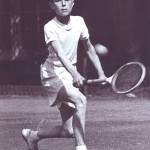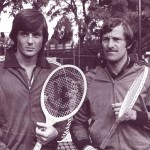From the early days in Prague to the victories in Grand Slam tournaments, we look at Jan Kodeš, the first world famous Czech tennis player
Disarming elegance. His movement between the court lines used to display a class above the norm, which along with extraordinary determination, led him to become the symbol of the new generation of players from the then Czechoslovakia. We are talking about Jan Kodeš, born in 1946, who in the sixties and seventies rose into the worldwide limelight, a precursor of the Ivan Lendls and Tomáš Berdychs that followed.
Born in Prague, and raised in the neighborhood of Karlín, at the age of 18 he had to choose between tennis and football, another discipline in which he showed great talent. It was a love for sport that didn’t take anything away from his school career: Kodeš was always a model student, so much so that, between training and an international tournament, even managed to attend university and graduate from the High School of Economics in Prague.
At just 20 years old he became part of ATP circuit and effectively became a professional. His extraordinary talent was visible to all, and within three years the youngster from Prague had completed a genuine maturation process that allowed him to become part of the greatest exponents of the sport internationally. His elegance certainly distinguished him, but it was not his only weapon, he possessed good drop shots and a great backhand, which could turn many game situations in his favour. It was a weapon that allowed him to prevail also in the greatest events in world tennis, such as in the three Grand Slam titles he won from 1970 to 1973. At the young age of 24, he managed to win the first tournament of his career, and managed it in Paris, on the red clay of Roland Garros. It was a surprise, especially for the more experienced opponent in the final, Željko Franulović, who was torn apart in 3 sets (6-2, 6-4, 6-4). It was here where he began his rise in top-level tennis. The following year in 1971, he began in the best possible way, by winning the Catania Open tournament, where in the final he allowed the Frenchman Georges Gouven to win just 5 games in 3 sets. In the same year he repeated his triumph at Roland Garros, and this time it was the Romanian Ilie Năstase who surrendered on September 4, in a particularly memorable match. The Czech won the first set with a score of 8-6, and with his stubbornness then won the second. Năstase opened the match by winning the third set 6-2, but in the decisive moment of the clash, all the talent of Kodeš emerged again, when the Bohemian “stole” the sixth service from his opponent and earned the third trophy of his career. From Paris he moved directly to the Iberian peninsula, in Barcelona to be precise, where the following year Kodeš got the better of Spaniard Manuel Orantes in his own backyard.
 Now that he had reached the fourth place in the ATP world ranking, the highest ranking of his career. In the same year the prestigious, yet equally discussed victory at Wimbledon would arrive, in what would be remembered as “the year of the boycott”. Indeed, since at that thirteen of the sixteen seeded players decided not to participate in the tournament in London as a sign of solidarity towards Nikola Pilić, the Yugoslavian tennis player who had been disqualified by the International Federation ILTF for refusing his national team’s call for the Davis Cup.
Now that he had reached the fourth place in the ATP world ranking, the highest ranking of his career. In the same year the prestigious, yet equally discussed victory at Wimbledon would arrive, in what would be remembered as “the year of the boycott”. Indeed, since at that thirteen of the sixteen seeded players decided not to participate in the tournament in London as a sign of solidarity towards Nikola Pilić, the Yugoslavian tennis player who had been disqualified by the International Federation ILTF for refusing his national team’s call for the Davis Cup.
From their point of view, the organizers saw it as an opportunity to include many English players among the participants, in order to create some enthusiasm among the British crowd. The move turned out to be spot on, with a public that did not fail to meet expectations, crowding the stands. Kodeš arrived in the semifinals after overcoming a young Borg and Armitraj. There he met the home favourite Roger Taylor, whom he defeated at the end of a game going down to the final shot lasting five sets and ending on a score of 6-1, 6-8, 3-6, 6-3, 7-5. This led the final act, the final, in which Jan Kodeš faced the Soviet Alex Metreveli, who he beat in 3 sets with a result of 6-1, 9-8, 6-3. The Czech won what many sports critics is defined as “the most prestigious trophy”.
Two years would pass before another trophy was won, this time in Madrid against Italian star Adriano Panatta, the bête noire of the Czechoslovakian champion. It was the third encounter between them, which would be followed by three more. The Italian was seen as the ‘‘opponent to beat” for Kodeš, who had never been able to overcome him in the previous clashes, and particularly wanted to make up for the final lost the same year in Kitzbuhel, Austria. The Czech tennis player on this occasion came out on top, winning by three sets to one, therefore adding the Madrid Masters to his titles. Kodeš and Panatta faced off three more times later, in Monte Carlo, Mexico City and at Roland Garros in Paris. In the end, it was always the Italian tennis player who won, each time more smoothly, and who in six head-to-head matches lost only once.
Despite not playing a single game, in 1980 Kodeš was also part of the Czechoslovakia team that won the Davis Cup, after defeating Italy in the final in Prague.
Regarding his relationship with Italian tennis, we must also remember the three finals of the Italian Open in Rome played by Kodeš unfortunately all ending in defeat. Among the great regrets of Kodeš, was also the fact that he never took home the US Open, the Grand Slam tournament played in the United States, where he twice reached the final, losing to Stan Smith (1971) and John Newcombe (1973), in addition to that the fact he had never participated in the Australian Open.
Kodeš retired on August 22, 1983 with a score of 421 wins and 245 defeats in singles matches and 313 victories and 183 defeats in doubles.
We recall, however, that his most important victory was the one he received last year, when a congenital heart problem, diagnosed during his youth years, and always dangerously understated due to his passion for tennis, forced him to undergo a delicate transplant. It was the umpteenth test that Kodeš had faced and overcome successfully.
Since 1990 he has been part of the “Tennis Hall of Fame”. All tennis fans and above all his colleagues and former opponents highlight his great fighting spirit, loyalty and sportsmanship on and off the court. A man of emotion and true values, who thanks to great technical skills and an exceptional elegance managed to climb the Olympus of the greats of tennis, entering the main door into the history of the sport.
by Alessandro De Felice









